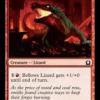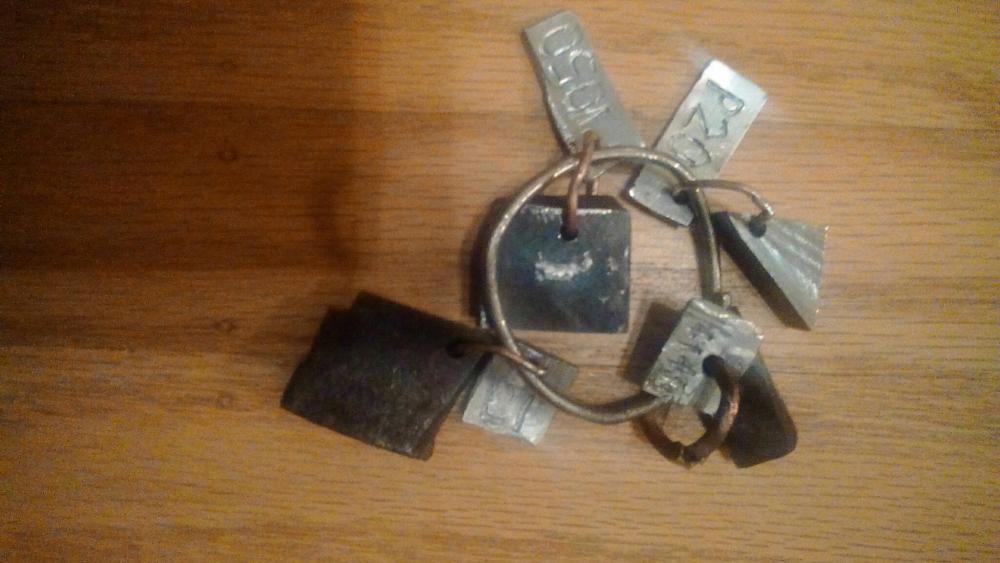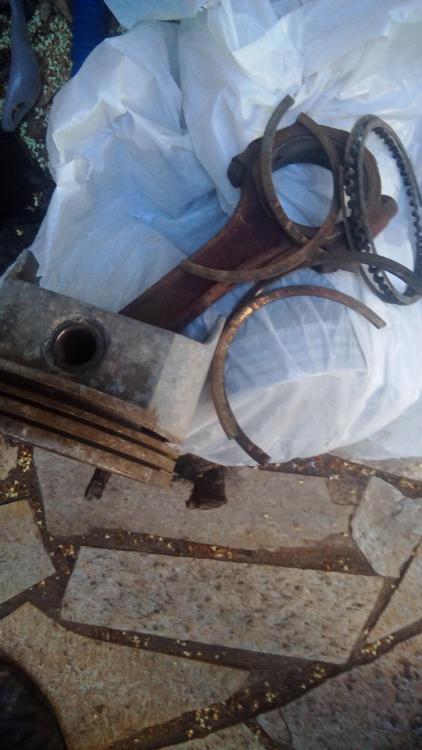-
Posts
817 -
Joined
-
Last visited
Profile Information
-
Gender
Not Telling
-
Location
Bay Area, California
Converted
-
Location
Bay Area, California
Recent Profile Visitors
The recent visitors block is disabled and is not being shown to other users.
-
Thanks, Thomas. I am very suspicious of sulfur. That would explain the somewhat shorter chips, too. When the end falls off of the piece of metal you are working on, you look around quickly to see if any of the other blacksmiths are watching. This most reminded me of forging M2 too hot. But that was more like cottage cheese. There was some kind of crumbly look, but not quite the same.
-
Hi. I had an interesting problem the other day. I was working on an open forge day, and I experienced some serious difficulties with a piece of found steel that I was working on. It was one of those concrete form stakes with the holes for wires in it. Normally, these are mild steel and are workable at reasonable temperatures. I found two of them in the street, and they ended up making some useful things. The third one I used was just terrible. After a few heats, the metal would crack off while hammering. It looked crystallized, like with grain growth problems or burnt metal. It couldn't have been either, because the metal was cracking at high red. I was pulling the steel out of the forge at a high drippy yellow with a tiny bit of sparking only at the tip. It's what I call a "Frank Turley" heat; he says get the metal hot and "git over it!". This heat has been ideal for forging mild steel, and I'm not afraid of it. It is iffy for medium carbon steel, and of course awful for high carbon steel. The metal would only survive about two heats before cracking, or more like crumbling. The break looked almost like forging cast iron. It was very embarrassing in a group setting, so I finally went to the grinder and looked at the sparks. It looked exactly like mild steel. No way it was even as high as an HC railroad spike. A file and hacksaw cut like it was mild steel. Very strange! I took the piece home and wondered how it would do on the lathe. It cut well. HSS with no chip breaker at 100 ft per minute gave good C's and 9's. Not medium carbon, since that would give strings without a chip breaker. The finish was OK, but not super smooth, so it wasn't leaded. Definitely not cast iron or anything like it, since that doesn't really draw a chip, more like black powder. Strange stuff. I suppose it is useful in the machine shop even if it is not forgeable. I wonder if it is weldable... A couple of lessons were learned. First, scrap metal can be a good find, but it could also be unpredictable. Second, just because one item works great doesn't mean that all similar items are made out exactly the same stuff. Would anybody know what impurity would cause the problems I experienced? The metal looked rough on the outside, but when the outside skin was turned off, it looked fine. I've pulled junk out of creeks that have had half their diameter pitted away, and they made great artistic forgings being worked at all reasonable temperatures.
-
Nice block, Frosty. Since I have a hardy hole in my anvil, as well as a stake plate, I rarely use my little swage block. I have half round bottom swages which drop into the hardy hole and are much more convenient. An engine hoist is a great idea. I have a couple of come-a-longs, but they are unwieldy for lifting due to the clearance required. I also have an engine hoist, but my forging area is over gravel, and it is difficult to roll it around there. I was thinking of some sort of gantry crane. It can be pretty flimsy because the block is only about 200 pounds (but that's enough to pinch a finger). Another idea that I just came up with is for a "wrench" that I can lever the block around with. Almost anything would be better than those fiddly levers shown in that YouTube video. They almost look like more trouble than they're worth. Thanks for all the suggestions, guys.
-
Glenn, you're right! Some kind of crane would really help. Every time I've used a large swage block, there have been plenty of minions. I worked with a smith once who was used to using heavy equipment. He had a bridge crane that he used to move everything. When I worked with him once, he wouldn't let me lift anything heavy. He would ask me to stand to the side while he operated the crane, and he made sure that the lifting apparatus was tucked safely away after each deployment.
-
Hi. I was asked to lead the blacksmithing for a restoration project that took a few weeks. I was glad to help, although some smiths criticized me for unpaid work. This was different though. The whole group were skilled craftspeople who really knew their specialties, and it was very educational to see the mechanical, woodworking, textile, painting and such going on. Besides, the camaraderie was delightful. All good things come to an end, though, and when the job was done they gave me a hearty thank you, which was all I needed. Imagine my surprise a couple of months later when they gave me a large swage block just out of the blue. I already have a couple of small ones, but this one is a monster. Although I'm grateful, I cannot safely single-hand it. I looked around for a stand design, and I found mostly stands for smaller, lighter blocks. Finally, I viewed this video by Gary Huston. This stand is dangerous! Go to the 34 minute mark which shows him changing orientations of the block. I can imagine trying to do this when I'm tired. There are just too many pinch points. Does anybody have a pointer to a safer design? I know, I know, "safety third", but I don't have Mike Rowe on speed-dial to help me handle this block. Maybe this is a multi-person block and I should just flip it when I am hosting a group activity.
-
There is a railway behind our company, and one day, when I was taking a walk, they performed a thermite weld on the track. I decided I needed a long break and stayed to watch. Anybody interested in more details can ask, but I had a couple of interesting observations. First, most of the time taken for the weld was used to preheat the track. They used a huge gasoline engine blown torch and got it good and hot. I think they were running it for at least half an hour. The gasoline engine ran a compressor which aspirated the burner. Second, the thermite burn was very controlled. I have seen thermite demonstrations, and the rail welding was nothing like it. There were essentially no sparks or flashes, and just a thin wisp of smoke emanating from the reaction vessel. This was surprising to me, and they must have been using a mixture with some sort of moderator in it. Third, I walked by after they were done and looked at the discards. The sprue was huge. This is apparently necessary so that the junk stratifies at the top. The top of the sprue was ragged and porous. They used a magnesia thimble which was very robust. Still it was cracked. I could salvage a few pieces, but I didn't know what to do with them. They probably would have been better than firebricks for cast iron welds. The crew spent a lot of time grinding. They used huge conical wheels and a gasoline powered grinder. When the wheels were used up, they would throw it on the side of the tracks and chuck up another one. I have no doubt that this process would work for welding together a makeshift anvil, but may be too involved for any but the most dedicated tinkerers.
-

JLP Blacksmith Teaching Center.
evfreek replied to jlpservicesinc's topic in Building, Designing a Shop
Wow, Jennifer. Looking real good. Makes me want one. -
I use separate tags made out of aluminum and stamp those. The links are copper. Kind of like a blacksmith's keychain.
-

Hot cut tool not cutting
evfreek replied to Gabe Santoriello's topic in Hot Cuts, Anvil devils, metal cutting on the anvil.
Make sure that the length of the cut is not that long. That is the reason for having a slightly convex edge on the hot cut. Remember, focus the force into a small point. If you are trying to cut a 1" line in that leaf spring, you probably won't be able to hit it hard enough to make much headway. Once you establish a groove, progress will get better. -

Can recycled tires be used as fuel?
evfreek replied to evfreek's topic in Solid Fuels: Coal, Coke, Charcoal, Wood, etc
Hi Mike. I just happened on your post by chance. Thank you for these valuable insights. I did a web search with new terms inspired by your post and found this: https://www.researchgate.net/publication/310651238_The_Zinc_Issue_in_the_Utilization_of_Waste_Tires_Pyrolysis It states that the char, which I observed as nice clean coke, actually contained 4.6% zinc by weight. In a fire with an excess of oxygen, most of this stays in the ash, and ends up as a solid pollutant to be later leached into the water supply, or something like that. Under rich conditions, it can volatilize as zinc vapor due to reduction of zinc oxide. Anyway, I didn't get sick, thank goodness. Interestingly enough, I ran into the guy who suggested this idea to me. He is in the forklift battery recycling business now. The tire waste has long since been depleted, and now forewarned, I will steer clear of any more of it. -
What were you cutting, JHCC? I had an accident with a cutting wheel when I was cutting a piece of steel that was too thick. It is almost impossible to hold the tool straight in the kerf. The disk shattered, and a piece struck my finger. Somehow, it got around the guard. Fortunately, I had a face shield, safety glasses, leather apron and thick gloves, so it only hurt a lot. When I was in metal shop, the teacher wouldn't allow students to wear hats or gloves around rotating machinery. He had a special exception for blacksmiths. We could wear gloves and/or hats, and I think that you are safer with gloves when doing that risky stuff with the angle grinder. I don't mean wear gloves around the lathe. The teacher also allowed the blacksmiths to wear gloves around the machine tools, but I noticed that none of us ever put their gloved hands anywhere the rotating spindles. We usually kept them in our pockets or behind our backs, and took the gloves off even to touch a switch or handle.
-

First serious attempt at forge welding, failure...
evfreek replied to mcb's topic in Blacksmithing, General Discussion
I'm a little suspicious of that IR thermometer. Get a small piece of cast iron and place it on a chip of hard firebrick. That is a much better indicator of forge temperature for now. If it doesn't melt, you're a little cold. Also, pull those doors shut a bit. If you want to weld high carbon steel, don't use leaf springs. Many of them are not simple alloys. Do a spark test. Instead, start with a file, sandwiched in a folded piece of mild steel. Try using an old garage sale file like a Nicholson or Simonds. Some A-36 (modern mild steel) has a difficult time welding to itself. Also, do a stick test with two coathangers. You cannot miss that little sticky feel. I have to get things just right in my propane forge. It is kind of iffy. -
What kind of tool holder do you have? This lathe originally has a lantern tool post and Armstrong holders. The hole in the end is pretty small. If you are really tight or pressed for time, you can stuff the appropriate sized broken drill into the hole, and grind to a cutter shape. The fellow who did the doors on the building did this. He made custom door hardware for over 30 doors with a couple of broken drill bits.
-

Success at welding cast iron, but ...
evfreek replied to evfreek's topic in Welding/Fab General Discussion
I looked extensively at Craigslist and EBay, but only found expensive new rings. I've never seen these at garage sales. Then, at a storage unit clean out, I finally succeeded. They were seized and brittle, but I managed to break a couple out. They spark tested as cast iron, so that's good. They seemed a little hard, but a file will cut them. The third ring groove had a wavy thing and two thin springy rings which sparked as spring steel. I guess I can repurpose the pistons as pistonium as soon as I get a foundry setup working. Thank you for the suggestions. I'll report back on how well they work, but I have seen good results reported from the web. -

Success at welding cast iron, but ...
evfreek replied to evfreek's topic in Welding/Fab General Discussion
Wow. I overhauled an engine once, and just threw the old ones away. I don't have any friends who do this now, since the engines last so much longer. For now, I'm going to just use old pieces. But I will forge a tiny pair of tongs to feed the pieces since pliers don't work well and aren't safe.


